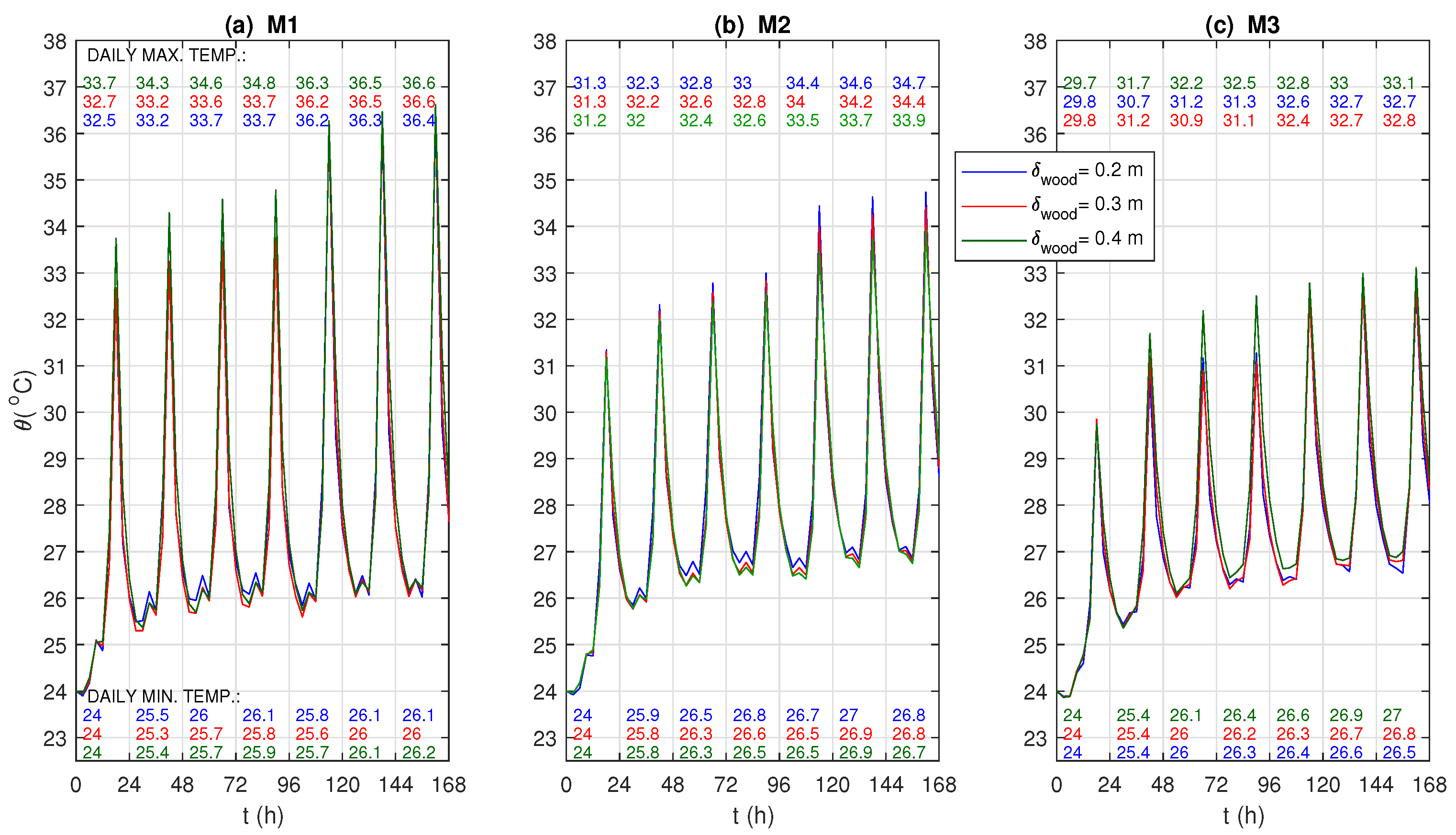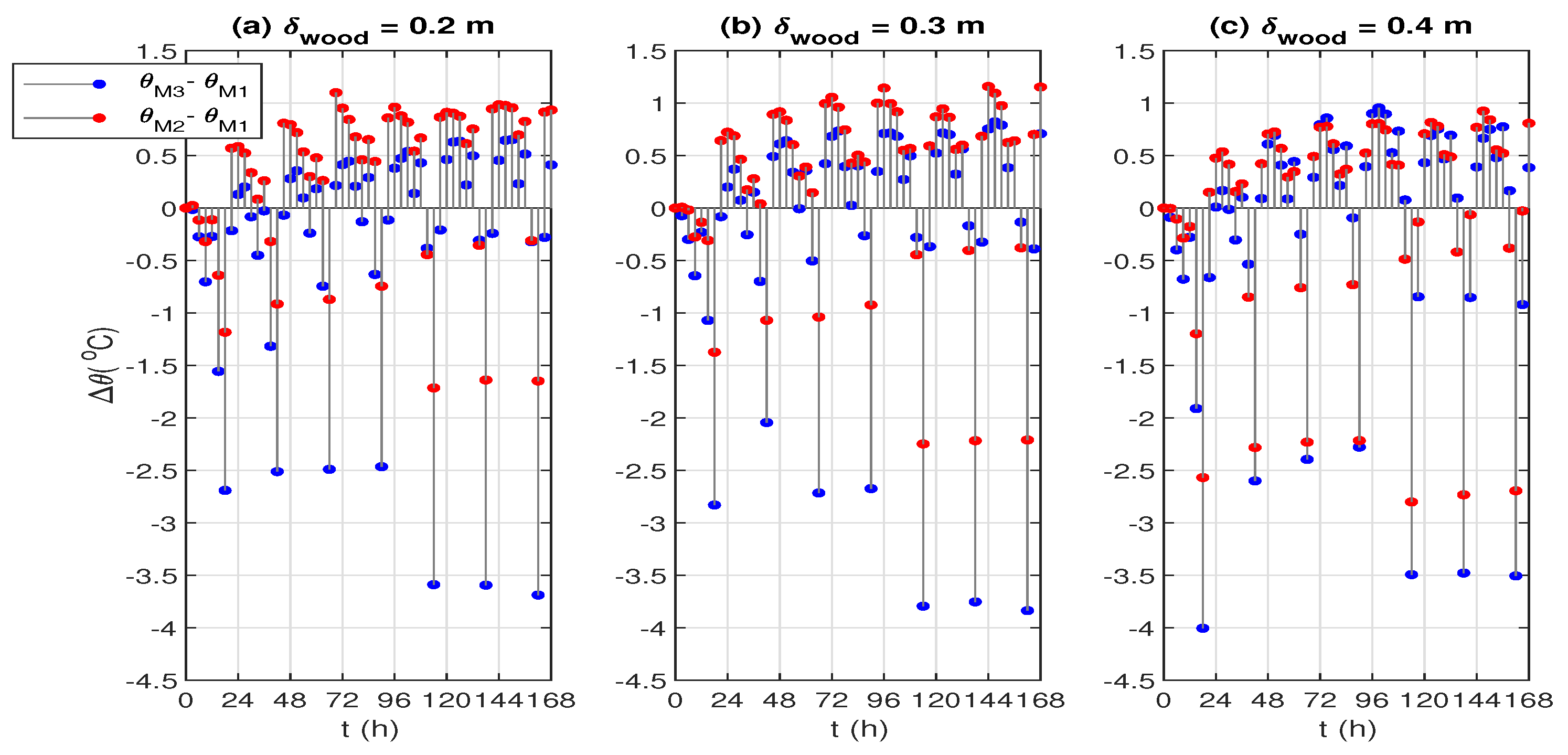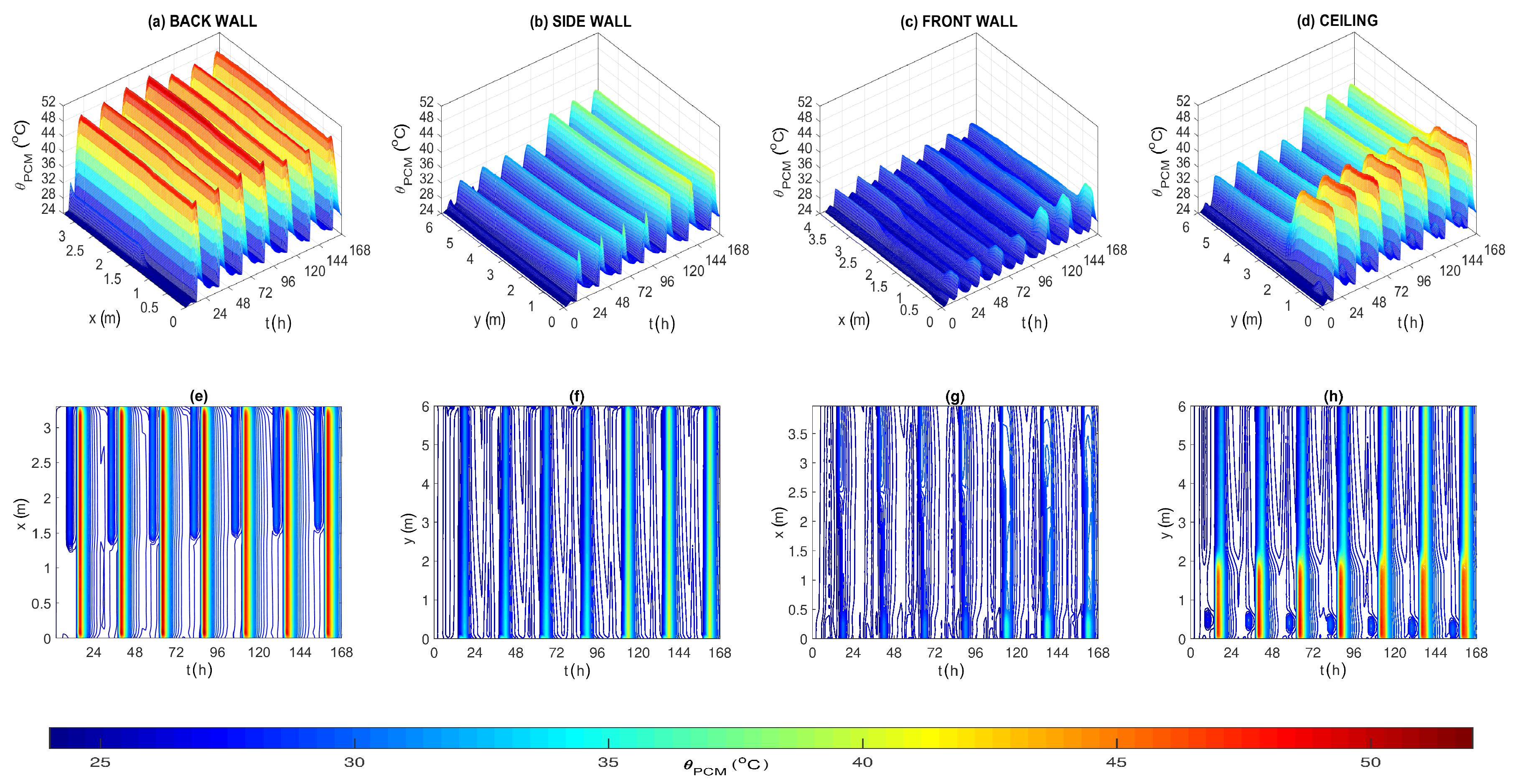Computer Simulation of Passive Cooling of Wooden House Covered by Phase Change Material
Abstract
1. Introduction

2. Methodology
2.1. Model Description
2.2. Physical Background
2.3. Simulation Conditions

| Material | Thermal | Density | Specific | Emissivity |
|---|---|---|---|---|
| Conductivity | Heat Capacity | |||
| Wood | 0.18 | 400 | 2510 | 0.89 |
| Glass | 0.76 | 2600 | 840 | 0.96 |
| PCM | 0.18 0.14 | 800 | 9000 | 0.99 |
2.4. Simulation Settings
3. Results of the Simulations
4. Discussion
5. Conclusions
Author Contributions
Funding
Conflicts of Interest
Abbreviations
| Specific heat capacity, | |
| h | Heat transfer coefficient, |
| L | Latent heat, |
| n | Normal vector, |
| q | Heat flow density, |
| Incident radiant heat flow per unit surface area, | |
| t | Time, |
| T | Thermodynamic temperature, |
| Ambient temperature, | |
| External temperature, | |
| Surface temperature, | |
| Initial temperature of a body, | |
| v | Fluid velocity, |
| x, y, z | Space coordinates, |
| Vapor mass fraction, | |
| Wall thickness, | |
| Thermal conductivity, | |
| Inner heat-generation rate per unit volume, | |
| Density, | |
| Temperature, (C) | |
| Convective exchange temperature, (C) | |
| Surface temperature, (C) | |
| Volume fraction, | |
| Emissivity, | |
| Stephan-Boltzmann constant, | |
| Model of a wooden house without the PCM coverage | |
| Model of a wooden house with all walls, except a floor, covered by the PCM | |
| Model of a wooden house with back wall (i.e., wall opposite the window) covered by the PCM | |
| PCM | Phase change material |
References
- Czech Statistical Office Residential and Non-Residential Construction and Buildings Permits—Time Series. Available online: https://www.czso.cz/csu/czso/bvz_ts (accessed on 4 November 2020).
- Adekunle, T.; Nikolopoulou, M. Thermal comfort, summertime temperatures and overheating in prefabricated timber housing. Build. Environ. 2016, 103, 21–35. [Google Scholar] [CrossRef]
- CSN EN 16789-1, Energy Performance of Buildings—Ventilation for Buildings—Part 1: Indoor Environmental Input Parameters for Design and Assessment of Energy Performance of Buildings Addressing Indoor Air Quality, Thermal Environment, Lighting and Acoustics—Module M1-6; Office for Technical Standardization, Metrology and State Testing: Prague, Czech Republic, 2020.
- Saffari, M.; De Gracia, A.; Ushak, S.; Cabeza, L. Economic impact of integrating PCM as passive system in buildings using Fanger comfort model. Energy Build. 2016, 112, 159–172. [Google Scholar] [CrossRef]
- Bergia Boccardo, L.; Kazanci, O.; Quesada Allerhand, J.; Olesen, B. Economic comparison of TABS, PCM ceiling panels and all-air systems for cooling offices. Energy Build. 2019, 205. [Google Scholar] [CrossRef]
- Al-Absi, Z.A.; Isa, M.H.M.; Ismail, M. Phase change materials (PCMs) and their optimum position in building walls. Sustainability 2020, 12, 1294. [Google Scholar] [CrossRef]
- Barzin, R.; Chen, J.J.; Young, B.R.; Farid, M.M. Application of PCM underfloor heating in combination with PCM wallboards for space heating using price based control system. Appl. Energy 2015, 148, 39–48. [Google Scholar] [CrossRef]
- Yan, T.; Xu, X.; Gao, J.; Luo, Y.; Yu, J. Performance evaluation of a PCM-embedded wall integrated with a nocturnal sky radiator. Energy 2020, 210. [Google Scholar] [CrossRef]
- Li, Y.; Nord, N.; Xiao, Q.; Tereshchenko, T. Building heating applications with phase change material: A comprehensive review. J. Energy Storage 2020, 31. [Google Scholar] [CrossRef]
- Faraj, K.; Khaled, M.; Faraj, J.; Hachem, F.; Castelain, C. Phase change material thermal energy storage systems for cooling applications in buildings: A review. Renew. Sustain. Energy Rev. 2020, 119. [Google Scholar] [CrossRef]
- Qiao, Y.; Cao, T.; Muehlbauer, J.; Hwang, Y.; Radermacher, R. Experimental study of a personal cooling system integrated with phase change material. Appl. Therm. Eng. 2020, 170. [Google Scholar] [CrossRef]
- Tang, L.; Zhou, Y.; Zheng, S.; Zhang, G. Exergy-based optimisation of a phase change materials integrated hybrid renewable system for active cooling applications using supervised machine learning method. Sol. Energy 2020, 195, 514–526. [Google Scholar] [CrossRef]
- Zhou, Y.; Zheng, S.; Liu, Z.; Wen, T.; Ding, Z.; Yan, J.; Zhang, G. Passive and active phase change materials integrated building energy systems with advanced machine-learning based climate-adaptive designs, intelligent operations, uncertainty-based analysis and optimisations: A state-of-the-art review. Renew. Sustain. Energy Rev. 2020, 130. [Google Scholar] [CrossRef]
- Skovajsa, J.; Zalesak, M. The use of the photovoltaic system in combination with a thermal energy storage for heating and thermoelectric cooling. Appl. Sci. 2018, 8, 1750. [Google Scholar] [CrossRef]
- Li, G.; Bi, X.; Feng, G.; Chi, L.; Zheng, X.; Liu, X. Phase change material Chinese Kang: Design and experimental performance study. Renew. Energy 2020, 150, 821–830. [Google Scholar] [CrossRef]
- Gholamibozanjani, G.; Farid, M. A comparison between passive and active PCM systems applied to buildings. Renew. Energy 2020, 162, 112–123. [Google Scholar] [CrossRef]
- Rucevskis, S.; Akishin, P.; Korjakins, A. Parametric analysis and design optimisation of PCM thermal energy storage system for space cooling of buildings. Energy Build. 2020, 224. [Google Scholar] [CrossRef]
- Hussein, M. Improvements of building envelope using passive cooling techniques to reduce the cooling load in hot-dry regions. Heat Transf. Asian Res. 2019, 48, 3831–3842. [Google Scholar] [CrossRef]
- Web of Science Platform. Available online: https://apps.webofknowledge.com (accessed on 4 November 2020).
- Hawes, D.; Banu, D.; Feldman, D. Latent heat storage in concrete. II. Sol. Energy Mater. 1990, 21, 61–80. [Google Scholar] [CrossRef]
- Kolacek, M.; Charvatova, H.; Sehnalek, S. Experimental and numerical research of the thermal properties of a PCM window panel. Sustainability 2017, 9, 1222. [Google Scholar] [CrossRef]
- Pasupathy, A.; Velraj, R. Effect of double layer phase change material in building roof for year round thermal management. Energy Build. 2008, 40, 193–203. [Google Scholar] [CrossRef]
- Xu, X.; Zhang, Y.; Lin, K.; Di, H.; Yang, R. Modeling and simulation on the thermal performance of shape-stabilized phase change material floor used in passive solar buildings. Energy Build. 2005, 37, 1084–1091. [Google Scholar] [CrossRef]
- Scalat, S.; Banu, D.; Hawes, D.; Parish, J.; Haghighata, F.; Feldman, D. Full scale thermal testing of latent heat storage in wallboard. Sol. Energy Mater. Sol. Cells 1996, 44, 49–61. [Google Scholar] [CrossRef]
- Neeper, D. Thermal dynamics of wallboard with latent heat storage. Sol. Energy 2000, 68, 393–403. [Google Scholar] [CrossRef]
- Kuznik, F.; Virgone, J. Experimental investigation of wallboard containing phase change material: Data for validation of numerical modeling. Energy Build. 2009, 41, 561–570. [Google Scholar] [CrossRef]
- Lai, C.-M.; Chen, R.; Lin, C.Y. Heat transfer and thermal storage behaviour of gypsum boards incorporating micro-encapsulated PCM. Energy Build. 2010, 42, 1259–1266. [Google Scholar] [CrossRef]
- Hasse, C.; Grenet, M.; Bontemps, A.; Dendievel, R.; Sallée, H. Realization, test and modelling of honeycomb wallboards containing a Phase Change Material. Energy Build. 2011, 43, 232–238. [Google Scholar] [CrossRef]
- Kuznik, F.; Virgone, J.; Johannes, K. In-situ study of thermal comfort enhancement in a renovated building equipped with phase change material wallboard. Renew. Energy 2011, 36, 1458–1462. [Google Scholar] [CrossRef]
- Zhou, D.; Zhao, C.; Tian, Y. Review on thermal energy storage with phase change materials (PCMs) in building applications. Appl. Energy 2012, 92, 593–605. [Google Scholar] [CrossRef]
- Baetens, R.; Jelle, B.P.; Gustavsen, A. Phase change materials for building applications: A state-of-the-art review. Energy Build. 2010, 42, 1361–1368. [Google Scholar] [CrossRef]
- Kuznik, F.; Virgone, J.; Noel, J. Optimization of a phase change material wallboard for building use. Appl. Therm. Eng. 2008, 28, 1291–1298, cited By 180. [Google Scholar] [CrossRef]
- Soares, N.; Costa, J.; Gaspar, A.; Santos, P. Review of passive PCM latent heat thermal energy storage systems towards buildings’ energy efficiency. Energy Build. 2013, 59, 82–103. [Google Scholar] [CrossRef]
- Sun, W.; Zhang, Y.; Ling, Z.; Fang, X.; Zhang, Z. Experimental investigation on the thermal performance of double-layer PCM radiant floor system containing two types of inorganic composite PCMs. Energy Build. 2020, 211. [Google Scholar] [CrossRef]
- Kong, X.; Wang, L.; Li, H.; Yuan, G.; Yao, C. Experimental study on a novel hybrid system of active composite PCM wall and solar thermal system for clean heating supply in winter. Sol. Energy 2020, 195, 259–270. [Google Scholar] [CrossRef]
- Wang, T.; Guan, Y.; Hu, W.; Yang, H.; Guo, J.; Zhang, R. Experimental study on improving thermal environment in solar greenhouse with active—Passive phase change thermal storage wall. Environ. Sci. Eng. 2020, 1243–1252. [Google Scholar] [CrossRef]
- Hagenau, M.; Jradi, M. Dynamic modeling and performance evaluation of building envelope enhanced with phase change material under Danish conditions. J. Energy Storage 2020, 30. [Google Scholar] [CrossRef]
- Ye, R.; Huang, R.; Fang, X.; Zhang, Z. Simulative optimization on energy saving performance of phase change panels with different phase transition temperatures. Sustain. Cities Soc. 2020, 52. [Google Scholar] [CrossRef]
- Zhu, N.; Li, S.; Hu, P.; Lei, F.; Deng, R. Numerical investigations on performance of phase change material Trombe wall in building. Energy 2019, 187. [Google Scholar] [CrossRef]
- Guan, Y.; Wang, T.; Tang, R.; Hu, W.; Guo, J.; Yang, H.; Zhang, Y.; Duan, S. Numerical study on the heat release capacity of the active-passive phase change wall affected by ventilation velocity. Renew. Energy 2020, 150, 1047–1056. [Google Scholar] [CrossRef]
- Li, M.; Gui, G.; Lin, Z.; Jiang, L.; Pan, H.; Wang, X. Numerical thermal characterization and performance metrics of building envelopes containing phase change materials for energy-efficient buildings. Sustainability 2018, 10, 2657. [Google Scholar] [CrossRef]
- Herbinger, F.; Desgrosseilliers, L.; Groulx, D. Thermal Modeling in a Historical Building—Improving Thermal Comfort through the Siting of a Passive Mass of Phase Change Material; COMSOL Inc.: Boston, MA, USA, 2014; pp. 1–7. [Google Scholar]
- Kylili, A.; Theodoridou, M.; Ioannou, I.; Fokaides, P. Numerical Heat Transfer Analysis of Phase Change Material (PCM)—Enhanced Plasters; COMSOL Inc.: Munich, Germany, 2016; pp. 1–7. [Google Scholar]
- Gerlich, V.; Sulovska, K.; Zalesak, M. COMSOL Multiphysics validation as simulation software for heat transfer calculation in buildings: Building simulation software validation. Measurement 2013, 46, 2003–2012. [Google Scholar] [CrossRef]
- Neymark, J.; Judkoff, R. International Energy Agency Building Energy Simulation TEST and Diagnostic Method (IEA BESTEST). In-Depth Diagnostic Cases for Ground Coupled Heat Transfer Related to Slab-on-Grade Construction; National Renewable Energy Laboratory: Golden, CO, USA, 2008; pp. 549–572.
- Carslaw, H.; Jaeger, J. Conduction of Heat in Solids; Clarendon Press: Oxford, UK, 1992. [Google Scholar]
- Fan, Y.; Xu, K.; Wu, H.; Zheng, Y.; Tao, B. Spatiotemporal modeling for nonlinear distributed thermal processes based on KL decomposition, MLP and LSTM network. IEEE Access 2020, 8, 25111–25121. [Google Scholar] [CrossRef]
- Khovanskyi, S.; Pavlenko, I.; Pitel, J.; Mizakova, J.; Ochowiak, M.; Grechka, I. Solving the coupled aerodynamic and thermal problem for modeling the air distribution devices with perforated plates. Energies 2019, 12, 3488. [Google Scholar] [CrossRef]
- COMSOL. Heat Transfer Module User’s Guide; v. 5.3 Edition; COMSOL Multiphysics: Stockholm, Sweden, 2017. [Google Scholar]
- CSN 73 0540-3, Thermal Protection of Buildings—Part 3: Design Value Quantities; Office for Technical Standardization, Metrology and State Testing: Prague, Czech Republic, 2005. (In Czech)
- Charvatova, H.; Zalesak, M.; Kolacek, M.; Sehnalek, S. Experimental and Numerical Testing of Possibilities and Limits for Applications of Phase Changed Materials in Buildings. MATEC Web Conf. 2019, 292. [Google Scholar] [CrossRef]
- Oktay, H.; Yumrutas, R.; Argunhan, Z. An experimental investigation of the effect of thermophysical properties on time lag and decrement factor for building elements. Gazi Univ. J. Sci. 2020, 33, 492–508. [Google Scholar] [CrossRef]
- Jannat, N.; Hussien, A.; Abdullah, B.; Cotgrave, A. A comparative simulation study of the thermal performances of the building envelope wall materials in the tropics. Sustainability 2020, 12, 4892. [Google Scholar] [CrossRef]
- Charvatova, H.; Prochazka, A.; Zalesak, M. Computer simulation of temperature distribution during cooling of the thermally insulated room. Energies 2018, 11, 3205. [Google Scholar] [CrossRef]







| (a) Maximum Temperature (C) | |||||||
| PCM location | Day 1 | Day 2 | Day 3 | Day 4 | Day 5 | Day 6 | Day 7 |
| : Back wall | 49.3 | 50.3 | 50.7 | 50.9 | 49.0 | 49.1 | 49.2 |
| : Side wall | 32.2 | 32.9 | 33.3 | 33.5 | 38.8 | 39.2 | 39.6 |
| : Front wall | 25.7 | 29.5 | 29.9 | 30.1 | 30.3 | 30.5 | 30.7 |
| : Ceiling | 33.8 | 34.6 | 35.0 | 35.2 | 40.4 | 40.7 | 40.9 |
| : Back wall | 47.8 | 48.8 | 49.2 | 49.4 | 49.1 | 49.4 | 49.5 |
| (b) Minimum Temperature (C) | |||||||
| PCM location | Day 1 | Day 2 | Day 3 | Day 4 | Day 5 | Day 6 | Day 7 |
| : Back wall | 24.0 | 26.5 | 26.7 | 26.9 | 26.8 | 27.0 | 27.7 |
| : Side wall | 24.0 | 25.1 | 25.3 | 25.5 | 25.4 | 25.7 | 25.7 |
| : Front wall | 23.9 | 25.1 | 25.4 | 25.5 | 27.7 | 27.9 | 28.0 |
| : Ceiling | 24.0 | 25.3 | 25.7 | 25.8 | 25.8 | 26.0 | 26.1 |
| : Back wall | 24.0 | 26.5 | 26.7 | 26.9 | 26.8 | 27.0 | 27.0 |
| Wood Thickness | Model | Efficiency Of PCM Coverage (%) | ||||||
|---|---|---|---|---|---|---|---|---|
| Day 1 | Day 2 | Day 3 | Day 4 | Day 5 | Day 6 | Day 7 | ||
| 0.2 m | - | 10.1 | 8.7 | 7.7 | 14.7 | 14.7 | 14.9 | |
| - | 27.3 | 25.5 | 25.4 | 30.0 | 30.4 | 31.1 | ||
| 0.3 m | - | 11.4 | 11.1 | 9.4 | 17.8 | 16.5 | 15.9 | |
| - | 22.0 | 28.5 | 27.4 | 30.5 | 29.0 | 29.1 | ||
| 0.4 m | - | 22.2 | 21.1 | 20.5 | 22.8 | 21.9 | 21.4 | |
| - | 25.3 | 22.6 | 21.1 | 28.5 | 27.9 | 27.8 | ||
| Wood Thickness | Model | (a) Average Daily Temperature (C) | ||||||
| Day 1 | Day 2 | Day 3 | Day 4 | Day 5 | Day 6 | Day 7 | ||
| 0.2 m | 26.1 | 27.1 | 27.4 | 27.5 | 28.2 | 28.4 | 28.5 | |
| 26.0 | 27.5 | 28.1 | 28.3 | 28.6 | 28.8 | 28.9 | ||
| 25.5 | 26.8 | 27.3 | 27.5 | 28.0 | 28.2 | 28.2 | ||
| 0.3 m | 26.1 | 27.3 | 27.6 | 27.8 | 28.3 | 28.4 | 28.4 | |
| 26.0 | 27.4 | 27.8 | 28.1 | 28.4 | 28.7 | 28.8 | ||
| 25.5 | 27.0 | 27.3 | 27.5 | 28.0 | 28.3 | 28.4 | ||
| 0.4 m | 26.5 | 27.6 | 27.8 | 27.8 | 28.4 | 28.7 | 28.7 | |
| 26.1 | 27.5 | 27.9 | 28.1 | 28.4 | 28.7 | 28.8 | ||
| 25.6 | 27.3 | 27.8 | 28.2 | 28.3 | 28.5 | 28.6 | ||
| Wood Thickness | Model | (b) Range of Temperature Values (C) | ||||||
| Day 1 | Day 2 | Day 3 | Day 4 | Day 5 | Day 6 | Day 7 | ||
| 0.2 m | 8.7 | 7.9 | 7.9 | 7.9 | 10.6 | 10.4 | 10.6 | |
| 7.4 | 6.5 | 6.3 | 6.3 | 7.8 | 7.8 | 7.9 | ||
| 6.0 | 5.3 | 5.1 | 5.0 | 6.2 | 6.1 | 6.2 | ||
| 0.3 m | 8.6 | 7.7 | 7.7 | 7.7 | 10.3 | 10.2 | 10.4 | |
| 7.4 | 6.4 | 6.3 | 6.3 | 7.5 | 7.5 | 7.6 | ||
| 6.0 | 5.8 | 4.9 | 4.9 | 6.2 | 6.0 | 6.0 | ||
| 0.4 m | 9.8 | 8.9 | 8.9 | 8.9 | 10.5 | 10.4 | 10.5 | |
| 7.2 | 6.2 | 6.1 | 6.1 | 7.1 | 7.1 | 7.1 | ||
| 5.9 | 6.3 | 6.1 | 6.1 | 6.2 | 6.2 | 6.2 | ||
Publisher’s Note: MDPI stays neutral with regard to jurisdictional claims in published maps and institutional affiliations. |
© 2020 by the authors. Licensee MDPI, Basel, Switzerland. This article is an open access article distributed under the terms and conditions of the Creative Commons Attribution (CC BY) license (http://creativecommons.org/licenses/by/4.0/).
Share and Cite
Charvátová, H.; Procházka, A.; Zálešák, M. Computer Simulation of Passive Cooling of Wooden House Covered by Phase Change Material. Energies 2020, 13, 6065. https://doi.org/10.3390/en13226065
Charvátová H, Procházka A, Zálešák M. Computer Simulation of Passive Cooling of Wooden House Covered by Phase Change Material. Energies. 2020; 13(22):6065. https://doi.org/10.3390/en13226065
Chicago/Turabian StyleCharvátová, Hana, Aleš Procházka, and Martin Zálešák. 2020. "Computer Simulation of Passive Cooling of Wooden House Covered by Phase Change Material" Energies 13, no. 22: 6065. https://doi.org/10.3390/en13226065
APA StyleCharvátová, H., Procházka, A., & Zálešák, M. (2020). Computer Simulation of Passive Cooling of Wooden House Covered by Phase Change Material. Energies, 13(22), 6065. https://doi.org/10.3390/en13226065








